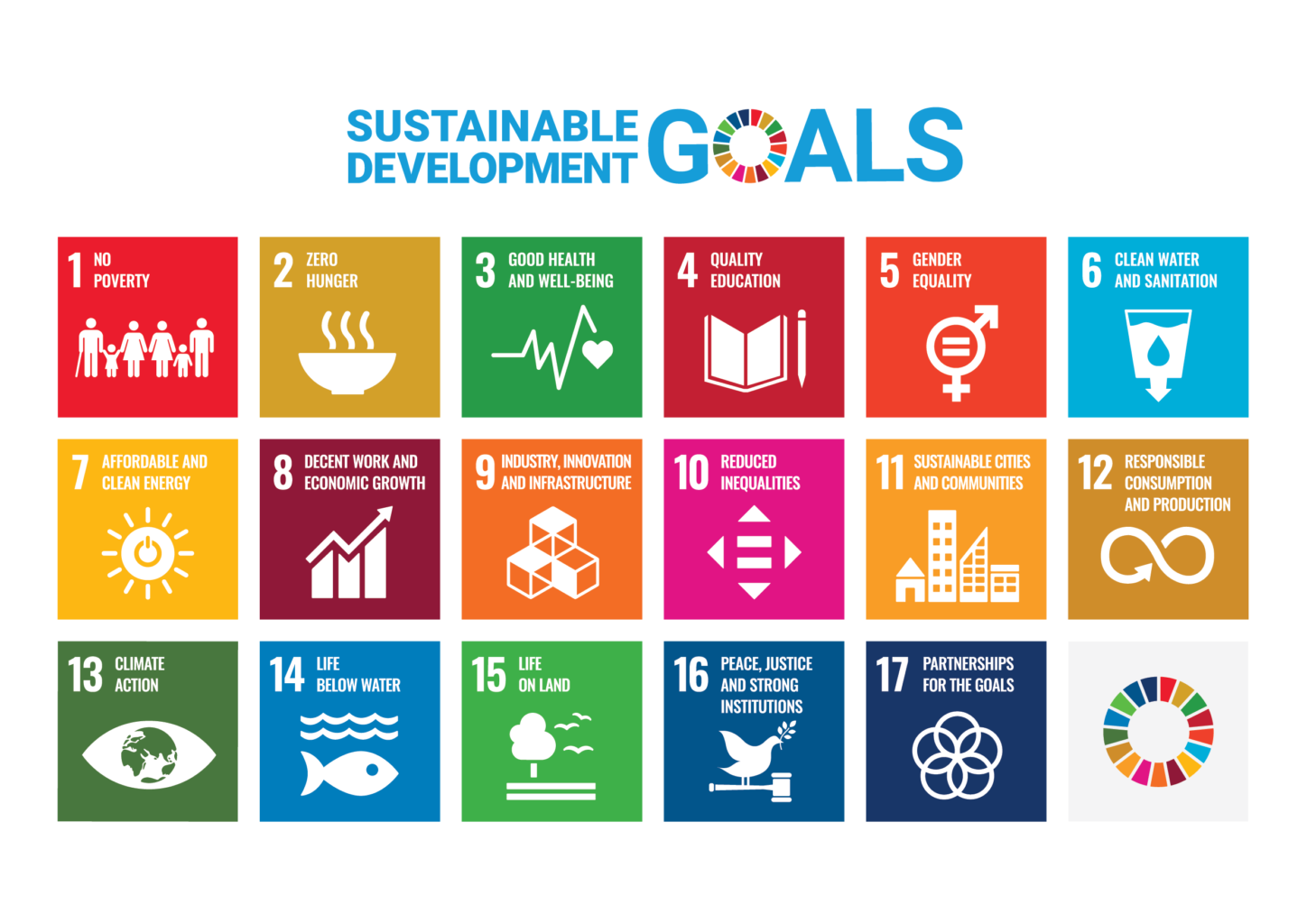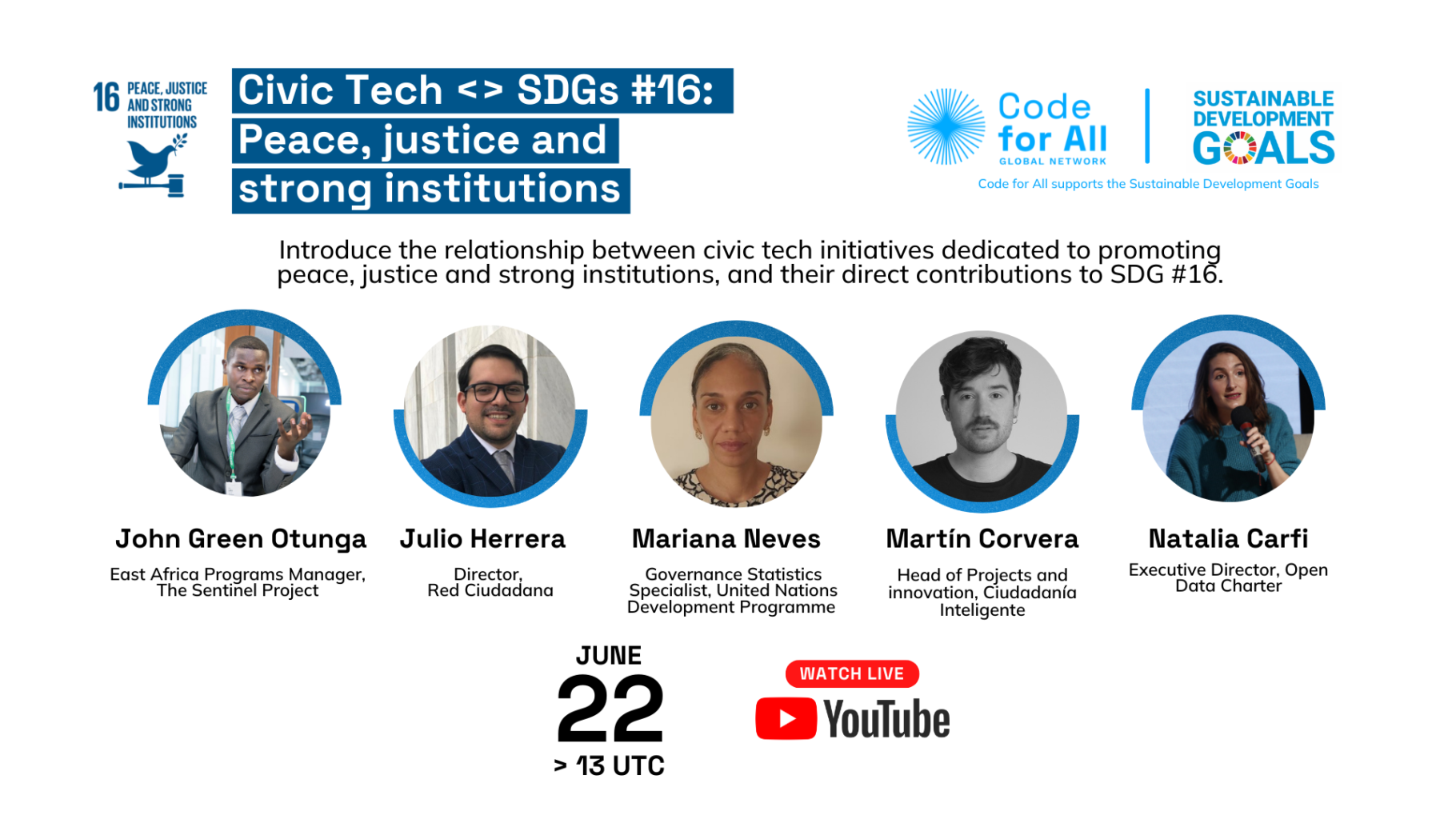Project Highlights & The Network
Peace and Prosperity for People and the Planet
Words by Lorin Camargo • Jul 21 2022
How civic tech is helping reach the United Nations Sustainable Development Goals (SDGs)
As we all know, our world has a lot of problems.
To name a few:
In 2015, more than 700 million people, or 10 percent of the world population, lived in extreme poverty. (Read more.)
Women and girls represent half of the world’s population, and therefore half of its potential, yet gender inequality persists everywhere and stagnates social progress. (Read more.)
Forests sustain us with the air we breathe, the water we drink, and the food we eat. But, globally, one fifth of the Earth’s land area (more than 2 billion hectares) are degraded. (Read more.)
The United Nations (UN) Sustainable Development Goals (SDGs) are helping to address our world’s biggest challenges, such as those mentioned above, and we believe civic tech is a tool that can be used to help reach these goals.
For this reason, we’ve started a series at Code for All focused specifically on the intersection of the SDGs and civic tech. This article is all about our new series, what we’ve learned so far, and what’s coming next.
But before we get into that, you might be wondering what exactly the SDGs are, and what civic tech is.
Here’s an explanation of both:
So, what are the SDGs? And, what is civic tech?
If you’re already familiar with these topics, feel free to jump ahead to the next section.
The SDGs are goals put forth by the UN to address some of the world’s biggest challenges, and the aim is to reach these goals by 2030.
There are 17 goals total, each one representing an ambitious target, which, if reached, will make the world a better place. As stated on the UN SDGs website, the goals provide, “a shared blueprint for peace and prosperity for people and the planet, now and into the future.”

For example, Goal #1 is: No Poverty. Living in a world with so much poverty, and such an unequal distribution of wealth, it’s difficult to imagine a huge goal like this ever being reached. If we can reach it, though, or even make a dent in reducing poverty around the world, it would certainly make the world a better place. So, why not reach for it?
What the UN has done for us by laying out these goals, is they’ve given us clear direction for what we should be aiming for. The targets have been painted, and it’s up to us (the people on this planet) to craft the right bows and arrows, practice our aim, and keep focused on those targets.
Now, on to civic tech.
Civic tech, in short, is technology that positively impacts society. To truly be civic tech, this technology needs to be created through a process that involves input from the community members that will be affected by it.
“Traditional tech helps with data, but civic tech helps with the process, trust and building community.” [Alma Rangel, Codeando México]
Another way to put it: it’s the intersection of technology, government, and public participation.
And what does Code for All have to do with all of this? Code for All is a network of civic tech organizations from around the world. Every organization in our network aims to create positive social change in their local regions using a combination of community and technology.
One of our goals as a network is to identify civic tech projects that have the potential to move from being a local-level project to a global-level project, and help them scale to that level.

So, in regard to civic tech and the SDGs, our aim is to identify civic tech projects from around the world that in some way address one or more of the 17 goals, and help support and scale those projects so they can make a bigger impact in the world, and help us all come closer to reaching the SDGs in a short amount of time.
Okay. Now that we’ve covered our jargon bases, let’s get into the nitty gritty.
How is civic tech actually helping the planet reach these goals?
“Both civic tech and the SDGs are about positively impacting society. The civic tech process can enable the achievement of the SDGs.” [Sheba Najmi, Code for Pakistan]
In the first session of our new SDG Series, we talked about the connection between civic tech and the SDGs, and discussed how civic tech in general can be used to address the goals.
Collaboration
One thing that civic tech does well is bring people together to collaboratively solve problems. During this initial discussion, all of our panelists agreed that collaboration is key to progressing toward the SDGs (for example, collaboration between governments and citizens, between private and public partners, and amongst civil society working toward similar goals).
“We are at a point where the problems we are trying to tackle cannot be tackled one-sided. Governments can’t do it alone, citizens can’t do it alone, NGOs can’t do it alone. So we really need to collaborate.” [Alma Rangel, Codeando México]
Civic tech can therefore be a great tool to help bring people and organizations together to collaboratively reach for the SDGs.

Inclusion
Civic tech also tends to bring people to the table who haven’t been invited in the past. In order to successfully work toward these goals, strong shifts in current systems of power need to occur. To solve these all-encompassing issues, people who have traditionally been left out need to be included in the process of decision-making. Civic tech can be used as a vehicle to bring underrepresented voices to the table.
“Civic tech has proven to be useful for human rights, not only for the articulation of activism in the digital space, but for generations of ethical technological applications for monitoring and accountability at the local level, as well as increasing participation of minority audiences and excluded audiences that are impacted by the climate crisis.” [Gloria Guerrero, Fundación AVINA]
An enabling environment
Lastly, civic tech is great at creating spaces that are productive for partnerships and problem solving. “Civic tech” might sound like it has a lot to do with the tech side of things, but as mentioned earlier, it’s more about the process than about the tech itself.
“One of the main lessons we have learned during these years is that technology by itself does not solve problems of democracy, it needs projects and political movements behind it.” [Martín Corvera, Ciudadanía Inteligente]
The civic tech process often involves creating welcoming and productive spaces, where multiple parties can work together to change, improve or strengthen existing systems. Events such as “hack nights” that invite anyone from the public to show up and participate in solving civic problems are common within the civic tech ecosystem.

Project examples
So far in the series, we’ve started to cover SDGs #13: Climate Action and #16: Peace, Justice and Strong Institutions.
Some of the projects that were shared include:
Monitoring air pollution and water contamination
Code for Africa’s Sensors.Africa project involves bringing communities together in multiple African cities to showcase evidence through sensor monitoring focused on air pollution and water contamination. Sensors.Africa seeks to give actionable information about the quality of a city’s air, water, sound, and radiation levels. In Nairobi, they have used sensor data to showcase the environmental situation of the area, leading to immediate action by the government including suspension of some officials and licenses to particular development.
Building a new constitution through Chilean citizenship
Ciudadanía Inteligente’s platform, La Constitución es Nuestra, enables civil society organizations to generate proposals for constitutional reform. In 2019, Chile experienced its biggest social movement of the last 30 years. People were demanding social justice, dignity, and minimum rights regarding education, health, and pensions. As a response, there was a political agreement in the Congress of Chile that proposed a new constitutional process. La Constitución es Nuestra helps to ensure NGOs, mobilized citizens, and marginalized groups who are not typically considered in the political discussion are included in this process of constitutional reform.
Opening data to respond effectively to policy challenges
Open Data Charter works with governments and civil society organizations to promote open data. This is important because, among other things, opening up governmental data can lead to increased transparency and accountability of public institutions. One of their projects focuses on fighting corruption. For this project, Open Data Charter works with several countries to understand what the high value assets are that governments should open in order to develop an ‘open data for anti corruption’ agenda. In collaboration with other civil society organizations, they created a tool called the Open Up Guide on anti-corruption, which explains 30 key data sets that governments should open.
You can find out about other projects that have been discussed in our SDG series by watching the full videos here.
What’s next
2030 isn’t far away, but the SDGs are far from being reached. There’s a lot of work to do, but with civic tech in our toolbox we may be able to get closer to reaching these goals.
Code for All’s SDG series will continue again in November of this year – we’re excited to share some more amazing projects from around the world with you!
We’ll be featuring panel discussions and lightning talks on our YouTube channel, each relating to a specific SDG we have not yet covered. You can stay up to date with the series by signing up for our mailing list here and ticking ‘events’, or you can subscribe to our YouTube channel.
How can you get involved?
If you’re an individual or organization using civic tech to help reach the SDGs, shoot us an email (lorin@codeforall.org) telling us about yourself, your project and which goal it is most aligned with. We’d love to hear from you, and would be excited to share your work in our series.
You can also join the Code for All Slack (look for our #sdg channel) to connect with others in the global civic tech community and take part in discussion about this or other civic tech topics. We hope to see you there!



